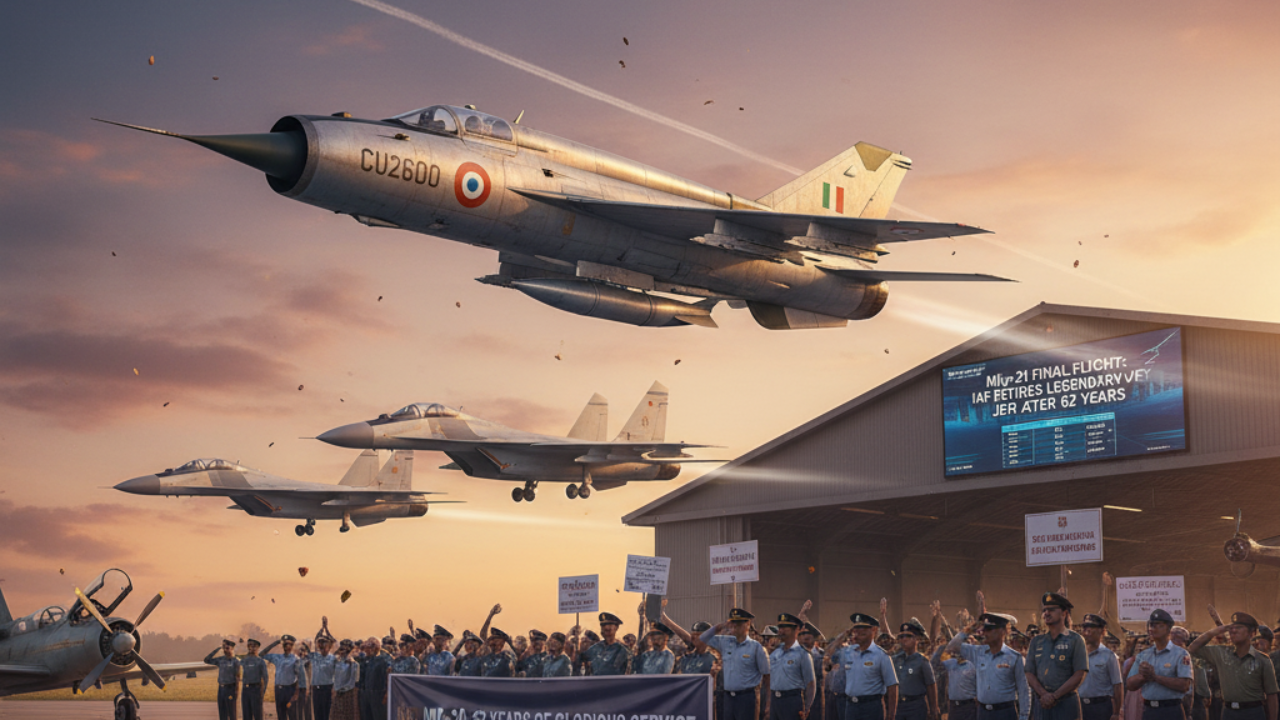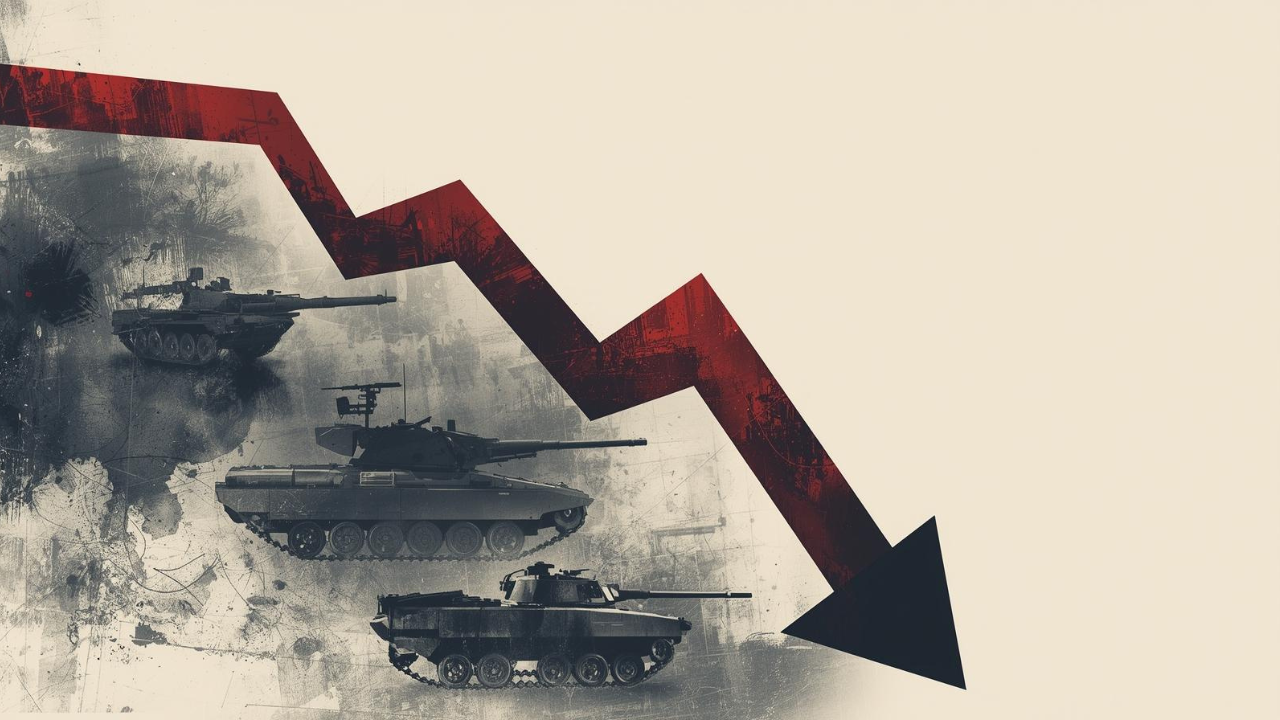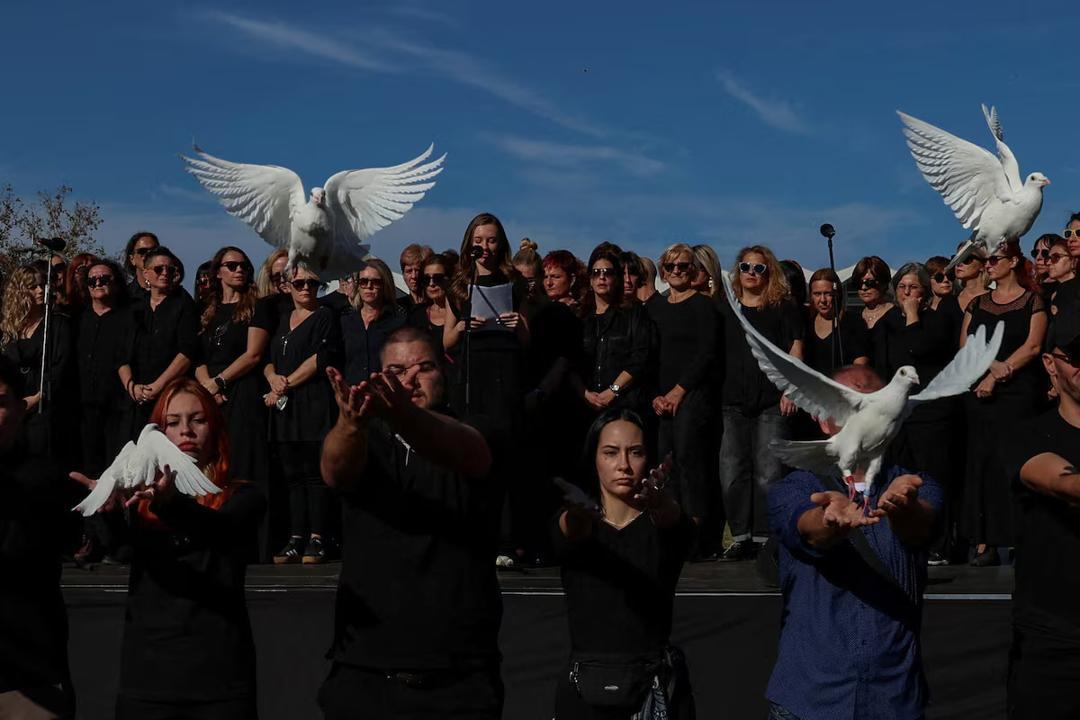
Post by : Shivani
In a poignant ceremony at Air Force Station Chandigarh on September 26, 2025, the Indian Air Force (IAF) bid an emotional farewell to the MiG-21 Bison, its first supersonic fighter jet, marking the end of a 62-year saga that defined generations of aerial combat and national pride. Dubbed the "missile with wings" for its blistering speed and compact design, the MiG-21 flew its final operational sorties, receiving a water cannon salute and a flypast that echoed its storied history from the battlefields of 1965 to the skies over Balakot in 2019.Defense Minister Rajnath Singh, addressing the gathering, called the MiG-21 a "family member" of the IAF, honoring the "courage, sacrifice, and excellence" of its pilots who flew over 850 aircraft across 24 squadrons and four training units.
Inducted in 1963 as a high-altitude interceptor to counter threats like the U.S. U-2 spy planes post the 1962 Sino-Indian War, the MiG-21 evolved into a versatile workhorse, symbolizing Indo-Soviet military ties and India's indigenous production prowess through Hindustan Aeronautics Limited (HAL). Yet, its retirement comes amid a bittersweet narrative: over 400 crashes claiming more than 200 pilots and 50 civilians, earning it the infamous moniker "flying coffin." As one chapter closes, the IAF looks to indigenous platforms like the Tejas to reclaim squadron strength, currently at a precarious 29 against a sanctioned 42.

The MiG-21's story begins in the 1950s at the Mikoyan-Gurevich Design Bureau in the USSR, where it emerged as a lightweight, supersonic interceptor capable of Mach 2 speeds. India, reeling from the 1962 border conflict, turned to the Soviet Union for rapid modernization. The first batch of 13 MiG-21s arrived in Chandigarh in 1963, flown by IAF pilots trained in the USSR, instantly transforming the force from subsonic to supersonic capabilities.
Licensed production at HAL's Nasik facility commenced soon after, with India becoming the largest operator outside the Soviet bloc. Over the decades, variants like the FL, M, Bis, and the upgraded Bison—fitted with advanced avionics, beyond-visual-range missiles, and electronic warfare suites—kept it relevant. The Bison, the final iteration, boasted a multi-mode radar and compatibility with R-73 missiles, extending its life into the 21st century despite design limitations from its Cold War origins.
Air Chief Marshal A.P. Singh, who flew the last solo sorties from Nal Air Force Station in Rajasthan on August 18-19, 2025, reflected: "The MiG-21 taught us the essence of fighter aviation—simplicity, speed, and unyielding spirit." Its compact frame, powered by a Tumansky R-25 turbojet, demanded razor-sharp piloting skills, fostering a cadre of aces who dominated Indo-Pak skirmishes.
The MiG-21's combat ledger is etched in India's military folklore. In the 1965 Indo-Pak War, it achieved the IAF's first supersonic intercept, downing a Pakistani Sabre. But it was the 1971 War where it shone brightest: IAF MiG-21s conducted precision strikes, seizing airfields and claiming nine kills, pivotal to Bangladesh's liberation.
High-altitude heroics defined its role in the 1999 Kargil conflict, where MiG-21s provided close air support amid oxygen-starved peaks, and in 2019's Balakot airstrikes, escorting Mirage 2000s deep into Pakistani territory. Operation Sindoor further showcased its versatility in ground-attack missions. Wing Commander Ajay Ahuja's tragic shootdown in 1999 underscored its risks, yet pilots like Group Captain Nirmal Jit Singh Sekhon, awarded the Param Vir Chakra posthumously for holding off 12 Sabres in 1971, immortalized its bravery.
Over 60 years, the MiG-21 logged millions of flying hours, training thousands of pilots and symbolizing Indo-Russian ties that endured geopolitical shifts. As Dinaker Peri noted in Business Standard, "From glory in 1971 to defending skies in 2019, it was both air power and industrial journey."
| Conflict/Event | Role | Key Achievements/Losses |
|---|---|---|
| 1965 Indo-Pak War | Interceptor | First supersonic kill; 3 confirmed victories |
| 1971 Indo-Pak War | Air Superiority & Ground Attack | 9 kills; Field airfields; PVC to Sekhon |
| 1999 Kargil War | Close Air Support | High-altitude ops; WC Ajay Ahuja's sacrifice |
| 2019 Balakot Strikes | Escort & Recon | Deep penetration missions; No losses |
| Total Service | - | 850+ aircraft; 400+ crashes; 200+ pilots lost |
Beneath the glory lay a grim toll. Since 1963, MiG-21s were involved in over 400 accidents, with single-engine design flaws, outdated avionics, and maintenance challenges cited as culprits. Notable tragedies include the 2020 crash killing Sqn Ldr Siddharth Negi and the 2022 trainer mishap claiming Wing Commander M. Rana and Flight Lieutenant Adivitiya Bal. Public outcry peaked after these incidents, with media dubbing it a "flying coffin" despite upgrades like the Bison variant's enhanced ejection seats and radar.
Retirement was long overdue, originally slated for 2022 but delayed due to squadron shortages as Tejas inductions lagged.The final two squadrons—No. 3 (Cobras) at Nal and No. 23 (Panthers) at Chandigarh—were phased out, dropping IAF strength below 1965 War levels. Experts warn this gap underscores the urgency for indigenous production ramps.
On X, sentiments poured in: "After nearly six decades, the MiG-21 takes its final bow—marking the end of an era," shared @TimesNow, while @BSBlueprint reflected on its "legacy of valor, speed, and supersonic firsts."
At its core, the MiG-21 was a marvel of simplicity: a delta-winged jet with a single R-25-300 engine delivering 9,900 kg thrust, achieving 2,175 km/h top speed and a 1,470 km combat radius. The Bison upgrade in the 2000s added a Phazotron Kopyo radar for 50 km detection, R-77 missiles, and GPS/INS navigation, making it a potent multi-role platform despite its 1950s roots.
Weighing just 5,700 kg empty, it excelled in dogfights with a 9g turn capability but struggled with payload (up to 1,000 kg) and endurance (45 minutes combat time). Pilots praised its agility: "It was like strapping a missile to your back," recalled Retd Air Commodore Surendra Singh Tyagi. Yet, single-engine vulnerability and limited countermeasures contributed to its high accident rate.
What becomes of the MiG-21 fleet? Private sales are off-limits under strict disposal policies, but airframes are in demand for displays. Institutions like museums, academies, and HAL facilities have queued up, with approvals routed through municipal offices for static exhibits. The IAF's Repair and Salvage Unit will maintain select ones annually, preserving history at bases like Chandigarh, where it all began.
Globally, MiG-21s linger in air forces like Croatia's (retiring 2024) and North Korea's, but India's phase-out cements its shift to 4.5-gen fighters. Some upgraded Bisos may find second lives in training or exports, echoing HAL's production of 1,200+ units.
As MiG-21s fade, the spotlight turns to the HAL Tejas Mk1A, with 64% indigenous content and upgrades like AESA radar and BVR missiles. Induction into No. 23 Squadron begins 2026, aiming to rebuild squadrons while Tejas Mk2 and AMCA promise self-reliance. "This retirement is a warning: Indigenization must accelerate," urged @CarnegieIndia. With 67 major enhancements, Tejas embodies Atmanirbhar Bharat, ready to soar where the MiG-21 once ruled.
X lit up with tributes: @Fliyingvyomee76 shared a video of the final bow, noting, "As one chapter closes, another takes flight with Tejas." @CNBCTV18News featured pilots' anecdotes, while #MiG21 trended with posts like "Garv se kaho, humne udaya tha yeh parindey!" Hashtags like #EndOfAnEra and #IAFLegend captured the nostalgia and resolve.
The MiG-21's retirement isn't just the end of a jet; it's the close of an era that forged India's aerial identity through fire and fury. From supersonic pioneer to sacrificial sentinel, it leaves a legacy of 62 years, over 850 souls in the sky, and lessons in resilience. As Tejas takes wing, the IAF honors its past while charging toward a Viksit Bharat in defense skies. The final flypast over Chandigarh wasn't goodbye—it was "see you in the history books.
Stay Informed: Follow @IAF_MCC for IAF updates or @DefenceMinIndia for policy insights. Explore more on aviation history at bharat-rakshak.com
#MiG21 #IAF #MiG21Retirement #FinalFlight #EndOfAnEra #IndianAirForce #BisonFarewell #AtmanirbharBharat #TejasRising #AerialLegacy










Advances in Aerospace Technology and Commercial Aviation Recovery
Insights into breakthrough aerospace technologies and commercial aviation’s recovery amid 2025 chall

Defense Modernization and Strategic Spending Trends
Explore key trends in global defense modernization and strategic military spending shaping 2025 secu

Tens of Thousands Protest in Serbia on Anniversary of Deadly Roof Collapse
Tens of thousands in Novi Sad mark a year since a deadly station roof collapse that killed 16, prote

Canada PM Carney Apologizes to Trump Over Controversial Reagan Anti-Tariff Ad
Canadian PM Mark Carney apologized to President Trump over an Ontario anti-tariff ad quoting Reagan,

The ad that stirred a hornets nest, and made Canadian PM Carney say sorry to Trump
Canadian PM Mark Carney apologizes to US President Trump after a tariff-related ad causes diplomatic

Bengaluru-Mumbai Superfast Train Approved After 30-Year Wait
Railways approves new superfast train connecting Bengaluru and Mumbai, ending a 30-year demand, easi